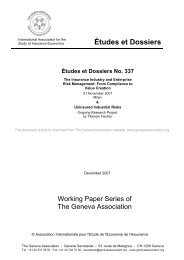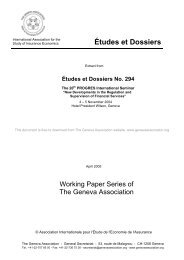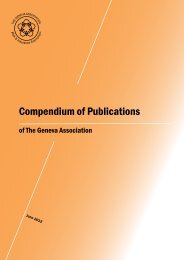Addressing the Challenge of Global Ageing?Funding Issues and
Addressing the Challenge of Global Ageing?Funding Issues and
Addressing the Challenge of Global Ageing?Funding Issues and
Create successful ePaper yourself
Turn your PDF publications into a flip-book with our unique Google optimized e-Paper software.
18<br />
<strong>Addressing</strong> <strong>the</strong> <strong>Challenge</strong> <strong>of</strong> <strong>Global</strong> <strong>Ageing</strong>—<strong>Funding</strong> <strong>Issues</strong> <strong>and</strong> Insurance Solutions<br />
chapter’s horizons <strong>and</strong> considers <strong>the</strong> broader economic <strong>and</strong> social implications <strong>of</strong> global<br />
ageing. The final section identifies <strong>and</strong> discusses six critical policy strategies.<br />
1. The demographic transformation<br />
The world st<strong>and</strong>s on <strong>the</strong> threshold <strong>of</strong> a stunning demographic transformation. For most<br />
<strong>of</strong> history, <strong>the</strong> elderly—defined throughout this chapter as adults aged 60 <strong>and</strong> over—<br />
only comprised a tiny fraction <strong>of</strong> <strong>the</strong> population, never more than 5 per cent in any<br />
country. That share first began to rise in what we now call <strong>the</strong> developed world during<br />
<strong>the</strong> Industrial Revolution <strong>of</strong> <strong>the</strong> 19th century. In <strong>the</strong> developed world today, <strong>the</strong> elderly<br />
comprise a little over 20 per cent <strong>of</strong> <strong>the</strong> population. By 2040, <strong>the</strong> share will reach 30 per<br />
cent—<strong>and</strong> this is just <strong>the</strong> average. In Japan <strong>and</strong> some faster-ageing European countries, it<br />
could be approaching or even passing 40 per cent1 (see Figure 1).<br />
Most developed countries will not only have ageing populations, but also stagnant or<br />
contracting ones. The working-age population has already begun to contract in several<br />
large developed countries, including Germany, Italy <strong>and</strong> Japan. By 2030, it will be<br />
contracting in nearly all developed countries, <strong>the</strong> only major exception being <strong>the</strong> United<br />
States. In a growing number <strong>of</strong> countries, <strong>the</strong> population as a whole will decline as well.<br />
Although it is today’s developed countries that are leading <strong>the</strong> way into humanity’s graying<br />
future, global ageing, as <strong>the</strong> name implies, is a global phenomenon. The developing world<br />
as a whole is still much younger, but it too is ageing—with some emerging markets<br />
traversing <strong>the</strong> entire demographic distance from young <strong>and</strong> growing to old <strong>and</strong> stagnant<br />
or declining at a breathtaking pace. By 2040, Brazil <strong>and</strong> Indonesia will be nearly as old<br />
as <strong>the</strong> United States <strong>and</strong> China will be older. Meanwhile, South Korea will be vying with<br />
Germany, Italy <strong>and</strong> Japan for <strong>the</strong> title <strong>of</strong> oldest country on earth.<br />
There are two forces behind <strong>the</strong> demographic transformation. The first <strong>and</strong> quantitatively<br />
more important force is falling fertility. People are having fewer babies, <strong>and</strong> this decreases<br />
<strong>the</strong> relative number <strong>of</strong> young in <strong>the</strong> population. As recently as <strong>the</strong> mid-1960s, every<br />
developed country was at or above <strong>the</strong> so-called 2.1 replacement rate needed to maintain a<br />
stable population from one generation to <strong>the</strong> next. Today, every developed country is at or<br />
below it—<strong>and</strong> most are far below it. In Germany <strong>and</strong> Italy, <strong>the</strong> fertility rate is just 1.4 <strong>and</strong><br />
in Japan it is just 1.3. Although <strong>the</strong> trend toward lower birthrates began in <strong>the</strong> developed<br />
world, it has now overtaken most <strong>of</strong> <strong>the</strong> developing world as well. Fertility has fallen<br />
well beneath <strong>the</strong> replacement rate in all <strong>of</strong> East Asia. It is also well beneath replacement<br />
throughout Central <strong>and</strong> Eastern Europe, <strong>and</strong> it is near, at or beneath replacement in most<br />
<strong>of</strong> Latin America’s leading economies. Although higher, fertility rates are also falling<br />
rapidly in South Asia <strong>and</strong> much <strong>of</strong> <strong>the</strong> Muslim world. The only region largely bypassed<br />
by <strong>the</strong> trend is sub-Saharan Africa.<br />
The second force is rising life expectancy. People are living longer, <strong>and</strong> this increases<br />
<strong>the</strong> relative number <strong>of</strong> elderly in <strong>the</strong> population. Worldwide, life expectancy at birth<br />
has increased by roughly 20 years since 1950, a larger gain over <strong>the</strong> past 60 years than<br />
humanity had achieved over <strong>the</strong> previous six thous<strong>and</strong>. In <strong>the</strong> developed world, life<br />
expectancy has now risen into <strong>the</strong> late seventies or early eighties in every country, <strong>and</strong><br />
1 Most <strong>of</strong> <strong>the</strong> demographic data cited in this chapter come from <strong>the</strong> United Nations Population<br />
Division (United Nations, 2011). For countries whose current (2005-2010 average) fertility rate is<br />
2.1 or lower, <strong>the</strong> projections refer to <strong>the</strong> UN’s “constant fertility” variant; for countries whose current<br />
fertility rate is above 2.1, <strong>the</strong>y refer to <strong>the</strong> UN’s “medium variant”.








